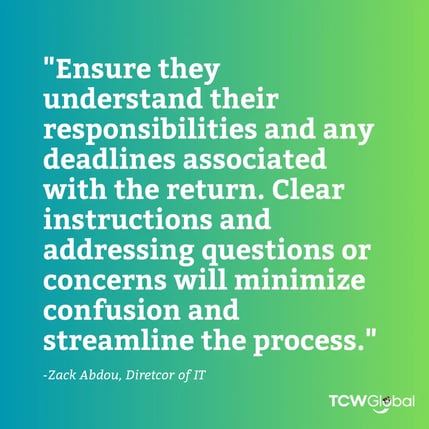How to Handle Remote Workers Returning Equipment

August 17, 2023

The rise of remote work has brought about significant changes in how businesses operate and introduced new approaches to work arrangements for both workers and employers.
However, as circumstances shift or employment ends, remote workers may need to return company-owned equipment. Effectively managing this process is crucial to safeguard company assets, maintain compliance, and preserve positive worker relations.
Here are some practical strategies to easily handle the return of equipment from remote workers, ensuring a smooth and seamless transition for everyone involved.
Communication is Key
Clear and open communication is fundamental in any workplace scenario, and equipment return is no exception. As soon as the decision for equipment return is made, communicate the process to the remote worker.
Ensure they understand their responsibilities and any deadlines associated with the return. Clear instructions and addressing questions or concerns will minimize confusion and streamline the process.
Create a Detailed Inventory
Before initiating the equipment return process, compile a comprehensive inventory of all items issued to the remote worker.
This inventory should include laptops, monitors, keyboards, software licenses, mobile devices, and any other company property provided for remote work. Having a detailed list will help track and verify the return of each item, minimizing the risk of lost or unreturned equipment.
Define Return Dates and Methods
Work closely with the remote worker to set appropriate return dates and methods. Depending on the circumstances, returning the equipment in person or via a shipping method might be necessary.
Collaborate with the worker to determine the most convenient approach while ensuring the equipment is returned in a timely manner. If shipping is involved, provide the necessary instructions and cover any associated costs.
Conduct a Pre-Return Check
Before the remote worker returns the equipment, conduct a pre-return check to assess the condition of each item. This step helps identify any damages or missing components, enabling prompt resolutions and reducing potential conflicts. By documenting the condition of the equipment beforehand, you can maintain a fair and transparent process.
Prioritize Data Security
Data security is paramount during equipment return. Ensure the remote worker understands their responsibility to back up and delete any personal or sensitive data from company-issued devices. Offer guidance on data removal protocols, protecting both the company's information and the worker's privacy.

Logistics of Returns
If the remote worker returns equipment in person, consider setting up a designated drop-off location at a nearby office. Ensure there is a proper receiving process to confirm the returned items and issue a receipt acknowledging the return. If shipping is involved, coordinate with the remote worker to choose a reliable shipping method with tracking capabilities.
Acknowledge the Return
Once the equipment is returned, promptly acknowledge the receipt of each item and verify its condition against the pre-return check. Thank the remote worker for their cooperation and professional handling of the equipment return. Expressing gratitude reinforces positive worker relations and maintains goodwill.
Equipment Disposition
Decide on the disposition of returned equipment. Determine whether the items will be reallocated to other workers, recycled, refurbished, or retired based on their condition and company policies. Communicate the equipment's fate to the remote worker, ensuring transparency in the process.
Finalize Administrative Processes
Ensure all administrative tasks associated with the equipment return are completed. This includes updating company records, removing remote workers' access to company systems and accounts, and adjusting any financial implications related to equipment returns.
Collect Feedback
Post-equipment return, gather feedback from the remote worker about their remote work experience and the equipment provided. This information can be valuable for improving future remote work policies and procedures.
Final Word
Handling the return of equipment from remote workers is an essential aspect of managing a modern and adaptable workforce.
Businesses can ensure a smooth and efficient transition by establishing clear communication, preparing a detailed inventory, prioritizing data security, and implementing a well-structured return process.
A well-managed equipment return process protects company assets, fosters positive worker relations, and reinforces a sense of mutual trust and respect.
Embracing these best practices will help organizations navigate the challenges of remote equipment returns while maintaining a productive and harmonious work environment.
Next Steps
As a contingent workforce specialist, TCWGlobal understands the complexities of managing remote workers. Our extensive expertise and experience make us the perfect partner for anyone seeking assistance in managing their remote workforce.
TCWGlobal is dedicated to providing comprehensive solutions and expert guidance to businesses of all sizes.
